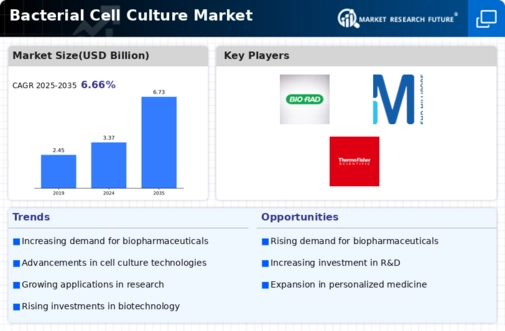Bacterial Cell Culture Size
Bacterial Cell Culture Market Growth Projections and Opportunities
Bacterial cell cultures are in high demand in biotech research and production, which is helping the market grow. The market grows because medical proteins, vaccines, and biologics can't be made without bacterial cell cultures. How common viral diseases are around the world affects sales of bacterial cell cultures. Bacterial cell cultures are very important for studying pathogens and making tests, vaccines, and antibiotics. Cell growth technology is always getting better, which changes how the market works. Market growth is being driven by bioreactor systems, process automation, and new culture medium formulas that make it easier to grow bacterial cells. Bacterial cell culture is in high demand because of recombinant DNA technology used in medicine and study. Recombinant proteins made from bacterial cell culture are very important for making medicines, vaccines, and industrial enzymes. The market is driven by the rise of biotechnology and bioprocessing. They have a bigger market because they are used in bioprocessing to make medicines, energy, and enzymes. The bacterial cell culture industry is driven by healthcare organizations, industrial businesses, and pharmaceutical companies that fund life sciences research. Bacterial physiology study and new treatments are what drive the demand for bacterial cell culture goods. Concerns about world health, especially pandemics, have an effect on sales of bacterial cell culture. Bacterial cell cultures are used to make vaccines against contagious diseases, which shows how ready the market is for an outbreak. The bacterial cell culture market is helped by the rise of CROs. The market for bacterial cell cultures is growing because CROs are important for contract research and them need them. Bacterial cell growth markets rely on rules being followed and government backing. Regulations and strict quality control methods make sure that bacterial cell culture products are safe and reliable, which grows the market. Genome editing tools like CRISPR-Cas9 have an effect on the bacterial cell culture business. These techniques make exact changes to the genes of bacterial cells, which lets scientists make strains with better traits that can be used in a wide range of situations. In bacterial cell culture, sustainability and the ability to grow are becoming more important. To meet the growing need for bacterial cell cultures that are better for the environment, new methods for bioreactors and sustainable culture medium are being created. Even though the market is good, the bacterial cell culture business has a hard time keeping pollution under control. Cell cultures that are contaminated can cause mistakes in study and production, so the control method needs to be improved all the time.







Leave a Comment